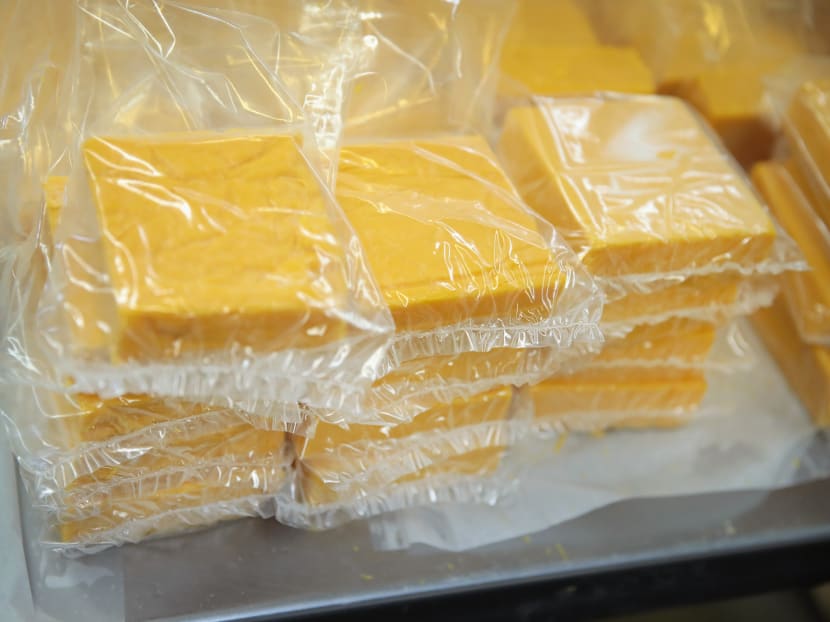Edible food packaging could soon be a reality: Researchers
NEW YORK — Much of the plastic packaging we see in the grocery store can be recycled, from egg containers, to milk jugs, to butter tubs. But what about that thin plastic film stretched around wedges of manchego in the cheese bin or the 16-ounce rib-eye in the chiller case?

Cheese packaged for sale. Edible, biodegradable packaging made of casein would be up to 500 times better than plastic at keeping oxygen away from food. Photo: AFP
NEW YORK — Much of the plastic packaging we see in the grocery store can be recycled, from egg containers, to milk jugs, to butter tubs. But what about that thin plastic film stretched around wedges of manchego in the cheese bin or the 16-ounce rib-eye in the chiller case?
It turns out that kind of plastic is tougher to recycle and might even be adding harmful chemicals to your food. Oh, and it is not even good at doing what it is supposed to do: prevent food spoilage.
Luckily, researchers are investigating alternative forms of food packaging — the kind you can eat.
US Department of Agriculture researchers have discovered that a milk protein called casein can be used to develop an edible, biodegradable packaging film. The casein-based film is up to 500 times better than plastic at keeping oxygen away from food because proteins form a tighter network when they polymerise, the researchers found. It is also more effective than current edible packaging materials made from starch and protects food products that are sensitive to light.
“Everything is in smaller and smaller packaging, which is great for grabbing for lunch, for school, but then it generates so much waste,” said Ms Laetitia Bonnaillie, a USDA researcher who co-led the casein packaging research. “Edible packaging can be great for that.”
To produce a more practical packaging material, the team added glycerol and citrus pectin to the casein film, which is made by spreading a mixture of water and commercially available casein powder. Glycerol made the protein film softer, and citrus pectin added more structure to the film, allowing it to resist humidity and high temperatures better. Ms Bonnaillie said the additives used by researchers also distinguish their packaging, because pectin is good for us.
Flavourings, vitamins, and other additives can be used to make the packaging, and the food it surrounds, tastier and more nutritious.
“These films will be more health-enhancing than starches,” Ms Bonnaillie said.
One of the potential applications could be as a dissolving packet of dried coffee or soup. Instead of tearing the top off and pouring it out, you just drop the whole thing in hot water, and it dissolves, adding protein to boot. Another is as single-serve food wrappers that use large amounts of plastic for such products as cheese sticks.
“I use these a lot, and my thought every time is there’s almost more plastic than cheese,” Ms Bonnaillie said.
Because the casein film dissolves in water, one of the main drawbacks to single-serve pouches is that they would need larger, nondissolving plastic or cardboard containers to keep them clean and dry. Bonnaillie said many packages already have an outer layer, however, so in a multi-layer system with secondary packaging, casein would still help the environment.
Casein in liquid form can serve as packaging and food. It can be sprayed onto cereal flakes and bars. Many cereals currently maintain their crunch because of a sugar coating but could achieve the same goal without sugar using the milk protein.
It could even be used to line pizza boxes. While the US Food and Drug Administration banned perfluorinated chemicals, which used to coat the cardboard surrounding your pepperoni, sausage, and extra cheese pie, a sprayed-on casein coating could serve as an alternative product to prevent grease and stains.
Unless companies try finding their own applications of the casein packaging, it will be many years before the USDA researchers can make it available, Ms Bonnaillie said. She said they are at the very beginning of a process of finding applications for a product that has the potential to be “so much better than plastic”. BLOOMBERG





